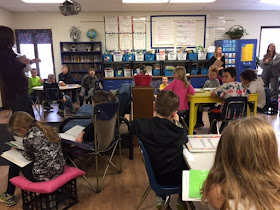This week I facilitated my first student-centered learning lab with our 4th and 5th grade staff. I have been a part of learning labs before both as the host teacher and as an observer, but being a facilitator is very new to me.
In my previous experiences in labs, they were more of a model classroom set up. The focus was teacher centered and observers were observing how the host teacher was teaching and then would bring that implementation back to the classroom. This model classroom had received intensive coaching to ensure that they provided high-quality instruction to their students for teachers to observe.
I have been reading Diane Sweeney's book Student Centered Coaching.
. 
It has opened my eyes to a style of coaching that is less intrusive & judgemental. It's focus is on the students, which is why we are all in the profession. As Diane states, "The focus isn't on improving them but instead is on improving the achievement of their students." It also aligns with the way we discuss student writing by using the learning progressions with student on-demand pieces with the Units of Study. A perfect match!Our district has offered three 1/2 days for work to be done around the Units of Study in Writing by Lucy Calkins. This was our second 1/2 day. I asked for volunteers to be the host, and I had one brave and curious soul come forward. I met with this teacher ahead of time to explain the procedure and to get her thinking of a focus for the lab.
These were our thoughts for the day:
- The focus is on improving the achievement of our students.
- Use student observations/evidence to determine where the students are in their learning.
- Build a community of teachers who are skilled at analyzing student evidence to make decisions that best support student learning.
We followed Diane Sweeney's protocol for student-centered learning labs to help guide our thinking, observing and discussing. We began with a prebrief where our host teacher explained what was happening currently in her room and what her goal was for today. The goal was, "How can writing partnerships be productive?"
Then we brainstormed "look-fors". In a perfect world, what would writing partnerships look like/sound like? Then we had time to review the protocol and our expectations for time spent in the room.
Our next step was to watch the lesson with the focus on writing partnerships. Our host teacher did a fantastic job setting us up for the day and preparing the lesson to maximize our learning experience.
After the lesson we debriefed by using a "whip-around" procedure. In this model, the discussion moved along in an orderly fashion from one person to the next. I did give the option to pass, but no one did. We again followed Diane Sweeney's protocol for debriefing. In round 1 we discussed the student evidence/observations; in round 2 we discussed implications; in round 3 our host teacher responded to what was shared; and in round 4 each group member shared their next steps in instruction.
I was so pleased with how the learning lab went. I felt that all teachers were engaged and participated to their fullest potential. I also feel like our students are going to benefit from this experience, which is why we chose to use this format.




No comments:
Post a Comment